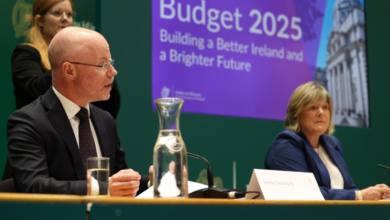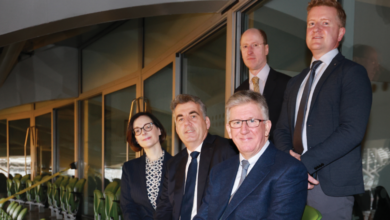eHealth Ireland Committee


The eHealth Ireland Committee was established to support the HSE Chief Information Officer through the review of implementation strategies and by advising on ICT investment decisions. The Committee meets on a quarterly basis and each individual possesses a relevant competency to fulfil the role. Currently there are 24 members, however recruitment for two additional patient representatives is about to begin.
Mark Ferguson, Director General, Science Foundation Ireland
Mark Ferguson is the eHealth Ireland Committee Chair. He is the recipient of numerous international research awards, including the 2002 European Science Prize, and has authored 327 research papers and book chapters.
“I am currently the Director General of Science Foundation Ireland – the largest government funder of competitive research proposals in all fields of science (including health) in Ireland. I am also the Chief Scientific Adviser to the Government of Ireland. Prior to that I was Professor in life sciences at the University of Manchester, UK and the co-founder and CEO of a biotechnology company, developing pharmaceutical drugs. My research interests are in the birth defect cleft palate, wound healing and scarring – particularly in the skin, sex determination, alligator and crocodile biology. My background training is in dentistry, anatomy, embryology and cell biology. I have a broad knowledge of the academic and industrial research landscape in Ireland including domains relevant to eHealth, e.g. software, Internet of Things, genomics, as well as an interest in many aspects of health and healthcare delivery.
The eHealth Ireland Committee acts as a sounding board, a source of ideas and a support framework for the CIO. It brings together individuals with relevant experience in the private and public sector as well as internationally. It aims to add value and assist the CIO in developing, for Ireland, the best eHealth system in the world – drawing on best practice, and ideas from around the world, in both the public and private sectors.
The Committee’s priorities are dictated by the priorities of the CIO in rolling out the best eHealth Ireland strategy. Current activities include the EHR, the successful implementation of eHealth systems in Irish maternity hospitals, the Lighthouse projects, gaining widespread patient, professional and public support and securing the necessary budget to implement the plan.”
Diane Nevin, Founder, Health Evident
Diane Nevin represents an innovation and start-up voice on the eHealth Ireland Committee providing an awareness of how to engage with start-ups and SMEs. Diane brings a focused ‘Ireland for Ireland’ view in order to ensure as much engagement with the Irish tech community as possible.
“My role as a member of the eHealth Ireland committee is to discuss, analyse, guide and support all projects that eHealth Ireland are developing and implementing within eHealth Irelands strategy and information plans.
My overall personal experience and expertise that facilitate my role as a committee member, would be having over 15 years’ experience in senior business management, operational strategies and technical project management. I currently lecture in entrepreneurship and innovation and have a passion for design thinking methodologies and change. I believe we require substantial changes within our health services if we are to meet our patients’ expectations now and in the future. eHealth Irelands commitment to meet these expectations, through the use of technology enabled solutions, is the way of the future.
As a committee, we have many current priorities, a key priority being the national EHR. The business case has been approved by the HSE and is currently with the Department of Health, Office and Administration. Important decisions will need to be made in the near future regarding the Government’s financial investment in order to move the project forward. Additional priorities are the Individual Health Identifier Programme, ePrescriptions, Cancer Care Clinical System and new Children’s Hospital.”
Eibhlín Mulroe, CEO, Cancer Trials Ireland
Eibhlín Mulroe is the CEO of Cancer Trials Ireland and was previously the CEO of IPPOSI. She has been involved in the eHealth Ireland Committee from the beginning and brings a patient and clinical trials focus to the work of eHealth Ireland. Eibhlín drives forward the cancer agenda from an IT point of view and helps to outline the rationale behind digital to the Department of Health.
“Cancer Trials Ireland is a not-for-profit, academic-led group which organises cancer trials in 14 participating hospital sites. We work globally with collaborative groups and industry to run clinical trials in our hospitals. Connected health and eHealth are very important in the clinical trials space, particularly with regards to having access to information on your patient population when you are considering running a clinical trial in Ireland.
Currently, information is collected in different ways at different hospitals and so a person’s information is never connected between their experience in one hospital and another. I think that’s a patient safety issue. I’m on the Committee with my experience as a CEO of the research group, but also as a citizen in Ireland who is concerned about how slow we are to adopt eHealth and adopt a means of connecting our information.
What Richard Corbridge has done is to ensure that members of the Committee are involved in some of the key eHealth conferences and meetings, helping to network people who wouldn’t necessarily have networked before. Another of the key things I’ve seen the CIO do is listen to advocate groups and involve them in the decision making around eHealth. That the patient and the public should be represented and understand what we do is very important.
The Committee’s big priority is to look at where we’re at and to drive forward the eHealth agenda for Ireland. It’s a long-term project which requires commitment from the State. Very often in healthcare we talk about buildings and capital spend, but this to me is as important. It will also mean greater research capability within the country than we currently have. At this stage, I’d like to see a commitment from those who make decisions on the eHealth agenda.”
Joe Peppard, Professor, European School of Management and Technology
Joe Peppard is a mentor of CIO Richard Corbridge and an internationally renowned educator of digital experts. He is the author of Strategic Planning for Information Systems, a seminal book on being a CIO and what it means to do digital in business, not exclusively health.
“I’m a professor at ESMT in Berlin and my main area of research is digitalisation. A lot of my research is outside of health and so I can bring in experiences of some other industries. While most people are from a health background it’s often beneficial to obtain a different perspective.
We’re acting in an advisory capacity alongside Richard and his team, particularly when he brings specific issues to the Committee for us to discuss. As members, we have an input and provide advice and guidance based on whatever experiences that we’ve had. We are reactive in some sense, but that doesn’t mean that we could not suggest that certain issues be included on the agenda. eHealth Ireland run events in conjunction with the IPPOSI and as a member we are invited to contribute.
The CIO is galvanising support around the opportunities that digitalisation present, not just in terms of the Irish health system, but in terms of patient care. We all recognise the value that technology can provide, however, those working in their capacity within the system may not have the same frame of reference or understanding that we might have. Giving them the time to step away and really see what opportunities technology can bring is important. One of the mantras that Richard is continually driving, even though we are talking about technology and digital, is that it’s not necessarily about technology per se. The success is person-orientated and this inevitably relies upon how well individuals are managed.”
James Batchelor, Director of Clinical Informatics Research Unit, Southampton University
James Batchelor is informatics expert based at Southampton University. His role is to deliver digital solutions for clinical research throughout the UK. James has a personal knowledge and interest in all things to do with information and data, particularly in health. He is an expert in genomics but also has an amazing knowledge of how we ensure that IT is clinician-friendly.
“I think I probably bring something in the sense that I’m an academic, but I have an experience of taking things that have been developed in academic terms and deploying them into real world delivery environments. I have a reasonable breadth of understanding of the minutiae of the clinical environment as well. I am reasonably attuned to the practicalities of implementation and I would hope that I bring some reasonably novel ways of dealing with problems. I think that Richard does that very well.
Having us as a Committee ensures that there is a dialogue about it that helps him think out his ambitions and vision, as well as taking on board multi-disciplinary feedback to help shape these. As a group, we can be a challenge, but I think that’s where we add value.
I think the eHealth programme is very much focused on not simply implementing technology for technology’s sake, it’s about implementing technology to provide a better patient experience than traditionally has happened and I think that is genuinely rare. Richard has a very different approach to the role of CIO which is extremely collaborative, which when delivering the eHealth Ireland programme is very important. I would say that the eHealth programme is a bit of triumph for Ireland and it presents a real opportunity to establish itself as an exemplar in Europe and possibly further afield.”





